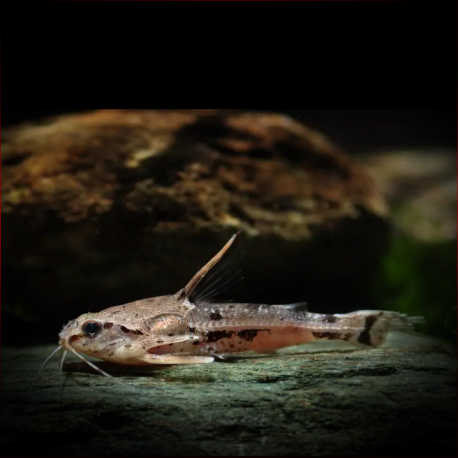More info
Datasheet
| Minimum Tank Size | 60 litres / 15.85 US gallons |
| Maximum Size | 7.5cm / 2.95inches |
| Temperature | 23°C / 73.40°F - 28°C / 82.40°F |
| Hardness | 2.02dgH / 36ppm - 20.00dgH / 357ppm |
| pH | 5.5-7.5 |
General Description
The Marbled Talking Catfish, scientifically known as Amblydoras Nauticus, was initially misidentified as A. hancockii and is also referred to as the Blue-eyed Catfish or Hancock's Doradid. This species is recognized for its hardiness and adaptability to varied water parameters, although it tends to be reclusive during daylight hours, making it an infrequent daytime sight in aquariums. It is named for its unique ability to produce sounds as a form of communication with other fish, a trait that has earned it the nickname "talking catfish."
Aquarium Setup
To best accommodate the Marbled Talking Catfish, it is recommended to house them in a tank with a South American biotope setup. This should include medium-sized tetras, peaceful cichlids, and catfish such as doradids, Corydoras spp., and Loricariids. Creating a densely planted environment with ample hiding spots, dim lighting, and a soft, sandy substrate is essential. The water conditions should ideally have a pH range of 5.5-7.5, hardness of 36-357ppm, and a temperature between 23-28°C (see table).
Behaviour
Marbled Talking Catfish are known to be peaceful inhabitants that may consume very small fish. They exhibit a non-aggressive temperament towards their own species and generally thrive in groups of three or more. These cats are primarily active during the night, making it ideal to offer food just before lights out as they predominantly feed in darkness.
Feeding and Diet
Their diet should consist of various foods, including catfish pellets, algae wafers, and live or frozen options. Incorporating live and frozen foods into their diet regularly is recommended to ensure proper nutrition. These catfish are opportunistic feeders and will accept a range of foods if provided.
Reproduction & Dimorphism
Reproduction of the Marbled Talking Catfish has not been observed in captivity. In their natural habitat, these fish are believed to build bubblenests among surface vegetation, which are guarded by the male. Sexual dimorphism includes spotted undersides in males, while females tend to have a rounder body shape as they mature.
Habitat and Distribution
The Marbled Talking Catfish is native to slow-moving and stagnant waters, including tributaries, creeks, and swamps in the Peruvian Amazon region. Endemic to the area, these catfish are typically found seeking shelter among roots or submerged vegetation and emerge in large schools at night to forage for food.

